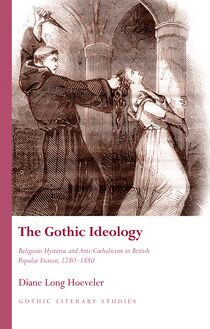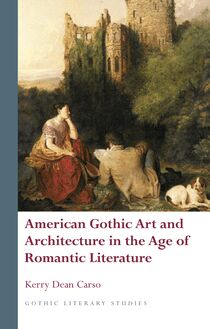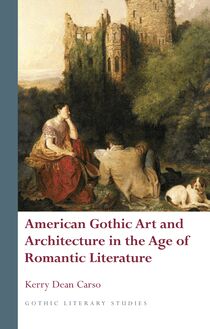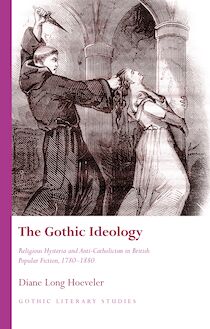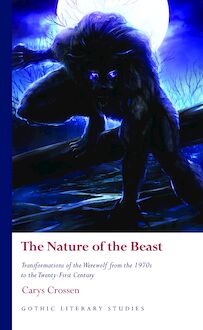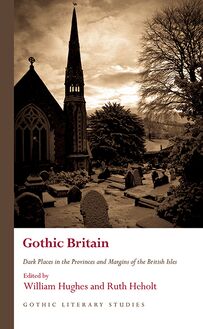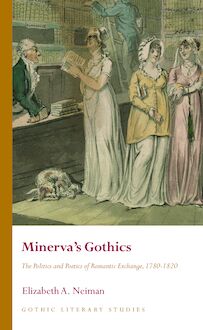-
 Univers
Univers
-
 Ebooks
Ebooks
-
 Livres audio
Livres audio
-
 Presse
Presse
-
 Podcasts
Podcasts
-
 BD
BD
-
 Documents
Documents
-
- Cours
- Révisions
- Ressources pédagogiques
- Sciences de l’éducation
- Manuels scolaires
- Langues
- Travaux de classe
- Annales de BEP
- Etudes supérieures
- Maternelle et primaire
- Fiches de lecture
- Orientation scolaire
- Méthodologie
- Corrigés de devoir
- Annales d’examens et concours
- Annales du bac
- Annales du brevet
- Rapports de stage
La lecture à portée de main
Vous pourrez modifier la taille du texte de cet ouvrage
Découvre YouScribe en t'inscrivant gratuitement
Je m'inscrisDécouvre YouScribe en t'inscrivant gratuitement
Je m'inscrisEn savoir plus
Vous pourrez modifier la taille du texte de cet ouvrage
En savoir plus

Description
Wolves lope across Gothic imagination. Signs of a pure animality opposed to humanity, in the figure of the werewolf they become liminal creatures that move between the human and the animal. Werewolves function as a site for exploring complex anxieties of difference – of gender, class, race, space, nation or sexuality – but the imaginative and ideological uses of wolves also reflect back on the lives of material animals, long persecuted in their declining habitats across the world. Werewolves therefore raise unsettling questions about the intersection of the real and the imaginary, the instability of human identities and the worldliness and political weight of the Gothic.
This is the first volume concerned with the appearance of werewolves and wolves in literary and cultural texts from the mid-nineteenth century to the present. Drawing on representations of werewolves and wolves in literature, film, television and visual culture, the essays investigate the key texts of the lycanthropic canon alongside lesser-known works from the 1890s to the present. The result is an innovative study that is both theoretically aware and historically nuanced, featuring an international list of established and emerging scholars based in Britain, Europe, North America and Australia.
Acknowledgements
List of Contributors
List of Illustrations
Introduction, Robert McKay and John Miller
Social Anxieties
1. Like Father Like Son: Wolf-Men, Paternity and the Male Gothic, Hannah Priest
2. Wicked Wolf-Women and Shaggy Suffragettes: Lycanthropic Femme Fatales in the Victorian and Edwardian Eras, Jazmina Cininas
3. Postcolonial Vanishings: Wolves, American Indians, and Contemporary Werewolves, Michelle Nicole Boyer
4. The Good, the Bad, and the Ubernatural: The Other(ed) Werewolf in Twilight, Roman Bartosch and Celestine Caruso
5. ‘Becoming woman’/Becoming Wolf: Girl Power and the Monstrous Feminine in the Ginger Snaps Trilogy, Batia Boe Stolar
Species Troubles
6. ‘Something that is either werewolf or vampire’: Interrogating the Lupine Nature of Bram Stoker’s Dracula, Kaja Franck
7. Saki, Nietzsche and the Superwolf, John Miller
8. A Vegetarian Diet for the Were-wolf Hunger of Capital: Leftist and Pro-animal Thought in Guy Endore’s The Werewolf of Paris, Robert McKay
9. Everybody Eats Somebody: Angela Carter’s Wolfish Ecology, Margot Young
10. ‘But by Blood No Wolf Am I’: Language and Agency, Instinct and Essence – Transcending Antinomies in Maggie Steifvater’s Shiver Trilogy, Bill Hughes
11. Transforming the Big Bad Wolf: Redefining the Werewolf through Grimm and Fables, Matthew Lerberg
Sujets
Informations
| Publié par | University of Wales Press |
| Date de parution | 15 septembre 2017 |
| Nombre de lectures | 0 |
| EAN13 | 9781786831040 |
| Langue | English |
| Poids de l'ouvrage | 1 Mo |
Informations légales : prix de location à la page 0,3450€. Cette information est donnée uniquement à titre indicatif conformément à la législation en vigueur.
Extrait
WEREWOLVES, WOLVES AND THE GOTHIC
SERIES PREFACE
Gothic Literary Studies is dedicated to publishing groundbreaking scholarship on Gothic in literature and film. The Gothic, which has been subjected to a variety of critical and theoretical approaches, is a form which plays an important role in our understanding of literary, intellectual and cultural histories. The series seeks to promote challenging and innovative approaches to Gothic which question any aspect of the Gothic tradition or perceived critical orthodoxy. Volumes in the series explore how issues such as gender, religion, nation and sexuality have shaped our view of the Gothic tradition. Both academically rigorous and informed by the latest developments in critical theory, the series provides an important focus for scholarly developments in Gothic studies, literary studies, cultural studies and critical theory. The series will be of interest to students of all levels and to scholars and teachers of the Gothic and literary and cultural histories.
SERIES EDITORS
Andrew Smith, University of Sheffield
Benjamin F. Fisher, University of Mississippi
EDITORIAL BOARD
Kent Ljungquist, Worcester Polytechnic Institute Massachusetts
Richard Fusco, St Joseph’s University, Philadelphia
David Punter, University of Bristol
Chris Baldick, University of London
Angela Wright, University of Sheffield
Jerrold E. Hogle, University of Arizona
For all titles in the Gothic Literary Studies series please visit www.uwp.co.uk
Werewolves, Wolves and the Gothic
edited by Robert McKay and John Miller
© The Contributors, 2017
All rights reserved. No part of this book may be reproduced in any material form (including photocopying or storing it in any medium by electronic means and whether or not transiently or incidentally to some other use of this publication) without the written permission of the copyright owner. Applications for the copyright owner’s written permission to reproduce any part of this publication should be addressed to the University of Wales Press, 10 Columbus Walk, Brigantine Place, Cardiff CF10 4UP.
www.uwp.co.uk
British Library Cataloguing-in-Publication Data
A catalogue record for this book is available from the British Library.
ISBN 978-1-78683-102-6
eISBN 978-1-78683-104-0
The publisher has no responsibility for the persistence or accuracy of URLs for any external or third-party internet websites referred to in this book, and does not guarantee that any content on such websites is, or will remain, accurate or appropriate.
Cover image: ©Shutterstock/Lori Labrecque
C ONTENTS
Acknowledgements
List of Contributors
List of Illustrations
Introduction, Robert McKay and John Miller
Social Anxieties
1 Like Father Like Son: Wolf-Men, Paternity and the Male Gothic
Hannah Priest
2 Wicked Wolf-Women and Shaggy Suffragettes: Lycanthropic Femmes Fatales in the Victorian and Edwardian Eras
Jazmina Cininas
3 Postcolonial Vanishings: Wolves, American Indians and Contemporary Werewolves
Michelle Nicole Boyer
4 The Good, the Bad and the Uber natural: The Other(ed) Werewolf in Twilight
Roman Bartosch and Celestine Caruso
5 ‘Becoming woman’/Becoming Wolf: Girl Power and the Monstrous Feminine in the Ginger Snaps Trilogy
Batia Boe Stolar
Species Troubles
6 ‘Something that is either werewolf or vampire’: Interrogating the Lupine Nature of Bram Stoker’s Dracula
Kaja Franck
7 Saki, Nietzsche and the Superwolf
John Miller
8 A Vegetarian Diet for the Were-Wolf Hunger of Capital: Leftist and Pro-animal Thought in Guy Endore’s The Werewolf of Paris
Robert McKay
9 Everybody Eats Somebody: Angela Carter’s Wolfish Ecology
Margot Young
10 ‘But by Blood No Wolf Am I’: Language and Agency, Instinct and Essence – Transcending Antinomies in Maggie Stiefvater’s Shiver Series
Bill Hughes
11 Transforming the Big Bad Wolf: Redefining the Werewolf through Grimm and Fables
Matthew Lerberg
A CKNOWLEDGEMENTS
The editors would like to thank the University of Sheffield and specifically the students in the School of English between 2012 and 2016, whose fees paid for the work that went into producing this book. They are also grateful to the editorial team at University of Wales Press. Robert would like to thank Gayle McKay and Tom Tyler. John would like to thank Ruth Hawthorn and colleagues at ASLE and ASLE-UKI.
L IST OF C ONTRIBUTORS
Editors
Robert McKay is Senior Lecturer in English Literature at the University of Sheffield. He wrote the interdisciplinary collection Killing Animals (University of Illinois Press, 2006) with the Animal Studies Group, and with John Miller and Susan McHugh co-edits the Palgrave Studies in Animals and Literature series.
John Miller is Senior Lecturer in Nineteenth-Century Literature at the University of Sheffield. He is the author of Empire and the Animal Body (Anthem, 2012), the co-author of Walrus (Reaktion Books, 2014), and the co-editor of a number of volumes including Transatlantic Literary Ecologies: Nature and Culture in the Nineteenth-Century Anglo-phone Atlantic World (Routledge, 2017).
Other contributors
Roman Bartosch teaches English Literatures at the University of Cologne. He has published on postcolonial and posthumanist theory and his book EnvironMentality – Ecocriticism and the Event of Postcolonial Fiction was published with Rodopi in 2013.
Michelle Nicole Boyer is currently studying in the department of American Indian Studies at the University of Arizona, with a focus in literature and film.
Celestine Caruso has a PhD in biology teaching and currently works for ZuS (Future Strategy for Teacher Education) at the University of Cologne.
Jazmina Cininas lectures at RMIT University School of Art, where she also completed her PhD, ‘The Girlie Werewolf Hall of Fame: Historical and Contemporary Figurations of the Female Lycanthrope’ in 2014. She has presented papers on female werewolves in Australia, UK, the USA and Hungary.
Kaja Franck has recently completed her PhD in the English Literature Department at the University of Hertfordshire. Her research interests include werewolves, ecoGothic and vampires in popular literature.
Bill Hughes was awarded a doctorate from the University of Sheffield in 2011 on the interrelation of the dialogue genre and eighteenth-century English novels. He has published on this topic and on Richard Hoggart, and has co-edited Open Graves, Open Minds: Representations of Vampires and the Undead from the Enlightenment to the Present Day (2011) with Sam George.
Matthew Lerberg received his PhD at the University of Texas, Arlington and is currently an instructor teaching courses on environmental humanities and animal studies. He has published work in Green Letters and Screening the Nonhuman: Representations of Animal Others in the Media .
Hannah Priest is an Associate Lecturer at Manchester Metropolitan University and an Honorary Research Associate at Swansea University. Her work explores intersections of sex, violence and the monstrous in late medieval literature, as well as in contemporary literature and film. She is the editor of She-Wolf: A Cultural History of Female Werewolves (Manchester University Press, 2015).
Batia Stolar is an Associate Professor in English at Lakehead University. Her articles on Jack Hodgins (with Andrew Lesk), Atom Egoyan, Michael Ondaatje and Austin Clarke have been published in Studies in Canadian Literature , Canadian Journal of Film Studies , New Essays on Atom Egoyan (Wilfrid Laurier UP), and Downtown Canada: Writing Canadian Cities (Toronto).
Margot Young is a practising psychoanalyst. She has published papers on the ‘Wolf-Man’ eco-psychology and the human/animal divide, and on Foucault and queer ecological critique.
L IST OF I LLUSTRATIONS
Figure 1: Laurence Housman, ‘The Race’, illustration for The Were-Wolf , 1896.
Figure 2: Laurence Housman, ‘The Finish’, illustration for The Were-Wolf , 1896.
Figure 3: Laurence Housman, ‘White Fell’s Escape’, illustration for The Were-Wolf , 1896.
Figure 4: Laurence Housman, ‘Sweyn’s Finding’, illustration for The Were-Wolf , 1896.
Figure 5: ‘Origin and Development of a Suffragette’, Millar & Lang Ltd. Art Publishers, c .1908. From the suffrage collection of Dr Kenneth Florey.
Figure 6: Martin Anderson, ‘We Want the Vote’, Cynicus Publishing Company, c .1910. Museum of London collection.
Introduction
ROBERT McKAY AND JOHN MILLER
After a while there was the low howl again out in the shrubbery, and shortly after there was a crash at the window, and a lot of broken glass was hurled on the floor. The window blind blew back with the wind that rushed in, and in the aperture of the broken panes there was the head of a great, gaunt grey wolf. 1
Wolves lope through the Gothic imagination. Signs of a pure animality opposed to the human, they become, in the figure of the werewolf, liminal creatures that move between the human and the animal: humans in animal form and animals in human form. They are metonyms of forbidding landscapes, an unsettling howl in the distance that marks the limit of the human world, or, as in the epigraph above from Bram Stoker’s Dracula (1897), the sign of a beastly intrusion into urban civility. Their imposing fangs and gaping mouths threaten an uncontrollable consumption. In their embodiment of the ravenous, the monstrous, the perverse and the excessive, werewolves function as a site for working out or contesting complex anxieties of difference: of gender, class, race, space, nation or sexuality; but the imaginative and ideological uses of wolves also reflect back on the lives of material animals, long demonised and persecuted in their declining habitats across the world. Wolves and werewolves, then, raise unsettling questions about the intersection of the real and the imaginary and the natural and the supernatural, foregrounding the instability of categories of human identity and the worldliness and political weight of the Gothic.
-
 Univers
Univers
-
 Ebooks
Ebooks
-
 Livres audio
Livres audio
-
 Presse
Presse
-
 Podcasts
Podcasts
-
 BD
BD
-
 Documents
Documents
-
Jeunesse
-
Littérature
-
Ressources professionnelles
-
Santé et bien-être
-
Savoirs
-
Education
-
Loisirs et hobbies
-
Art, musique et cinéma
-
Actualité et débat de société
-
Jeunesse
-
Littérature
-
Ressources professionnelles
-
Santé et bien-être
-
Savoirs
-
Education
-
Loisirs et hobbies
-
Art, musique et cinéma
-
Actualité et débat de société
-
Actualités
-
Lifestyle
-
Presse jeunesse
-
Presse professionnelle
-
Pratique
-
Presse sportive
-
Presse internationale
-
Culture & Médias
-
Action et Aventures
-
Science-fiction et Fantasy
-
Société
-
Jeunesse
-
Littérature
-
Ressources professionnelles
-
Santé et bien-être
-
Savoirs
-
Education
-
Loisirs et hobbies
-
Art, musique et cinéma
-
Actualité et débat de société
- Cours
- Révisions
- Ressources pédagogiques
- Sciences de l’éducation
- Manuels scolaires
- Langues
- Travaux de classe
- Annales de BEP
- Etudes supérieures
- Maternelle et primaire
- Fiches de lecture
- Orientation scolaire
- Méthodologie
- Corrigés de devoir
- Annales d’examens et concours
- Annales du bac
- Annales du brevet
- Rapports de stage

